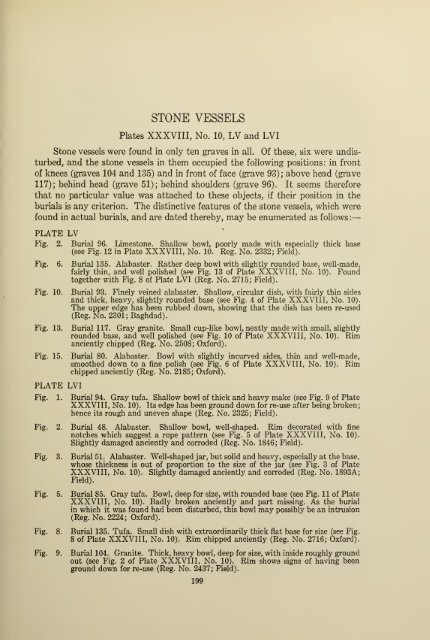A Sumerian Palace and the "A" cemetery at Kish, Mesopotamia
A Sumerian Palace and the "A" cemetery at Kish, Mesopotamia
A Sumerian Palace and the "A" cemetery at Kish, Mesopotamia
Create successful ePaper yourself
Turn your PDF publications into a flip-book with our unique Google optimized e-Paper software.
STONE VESSELS<br />
Pl<strong>at</strong>es XXXVIII, No. 10, LV <strong>and</strong> LVI<br />
Stone vessels were found in only ten graves in all. Of <strong>the</strong>se, six were undis-<br />
turbed, <strong>and</strong> <strong>the</strong> stone vessels in <strong>the</strong>m occupied <strong>the</strong> following positions: in front<br />
of knees (graves 104 <strong>and</strong> 135) <strong>and</strong> in front of face (grave 93) ; above head (grave<br />
117); behind head (grave 51); behind shoulders (grave 96). It seems <strong>the</strong>refore<br />
th<strong>at</strong> no particular value was <strong>at</strong>tached to <strong>the</strong>se objects, if <strong>the</strong>ir position in <strong>the</strong><br />
burials is any criterion. The distinctive fe<strong>at</strong>ures of <strong>the</strong> stone vessels, which were<br />
found in actual burials, <strong>and</strong> are d<strong>at</strong>ed <strong>the</strong>reby, may be enumer<strong>at</strong>ed as follows :<br />
PLATE LV<br />
Fig. 2. Burial 96. Limestone. Shallow bowl, poorly made with especially thick base<br />
(see Fig. 12 in Pl<strong>at</strong>e XXXVIII, No. 10. Reg. No. 2332; Field).<br />
Fig. 6. Burial 135. Alabaster. Ra<strong>the</strong>r deep bowl with slightly rounded base, well-made,<br />
fairly thin, <strong>and</strong> well polished (see Fig. 13 of Pl<strong>at</strong>e XXXVIII, No. 10). Found<br />
toge<strong>the</strong>r with Fig. 8 of Pl<strong>at</strong>e LVI (Reg. No. 2715; Field).<br />
Fig. 10. Burial 93. Finely veined alabaster. Shallow, circular dish, with fairly thin sides<br />
<strong>and</strong> thick, heavy, slightly rounded base (see Fig. 4 of Pl<strong>at</strong>e XXXVIII, No. 10).<br />
The upper edge has been rubbed down, showing th<strong>at</strong> <strong>the</strong> dish has been re-used<br />
(Reg. No. 2301; Baghdad).<br />
Fig. 13. Burial 117. Gray granite. Small cup-like bowl, ne<strong>at</strong>ly made with small, slightly<br />
rounded base, <strong>and</strong> well polished (see Fig. 10 of Pl<strong>at</strong>e XXXVIII, No. 10). Rim<br />
anciently chipped (Reg. No. 2508; Oxford).<br />
Fig. 15. Burial 80. Alabaster. Bowl with slightly incurved sides, thin <strong>and</strong> well-made,<br />
smoo<strong>the</strong>d down to a fine polish (see Fig. 6 of Pl<strong>at</strong>e XXXVIII, No. 10). Rim<br />
chipped anciently (Reg. No. 2185; Oxford).<br />
PLATE LVI<br />
Fig. 1. Burial 94. Gray tufa. Shallow bowl of thick <strong>and</strong> heavy make (see Fig. 9 of Pl<strong>at</strong>e<br />
XXXVIII, No. 10). Its edge has been ground down for re-use after being broken;<br />
hence its rough <strong>and</strong> uneven shape (Reg. No. 2325; Field).<br />
Fig. 2. Burial 48. Alabaster. Shallow bowl, well-shaped. Rim decor<strong>at</strong>ed with fine<br />
notches which suggest a rope p<strong>at</strong>tern (see Fig. 5 of Pl<strong>at</strong>e XXXVIII, No. 10).<br />
Slightly damaged anciently <strong>and</strong> corroded (Reg. No. 1846; Field).<br />
Fig. 3. Burial 51. Alabaster. Well-shaped jar, but solid <strong>and</strong> heavy, especially <strong>at</strong> <strong>the</strong> base,<br />
whose thickness is out of proportion to <strong>the</strong> size of <strong>the</strong> jar (see Fig. 3 of Pl<strong>at</strong>e<br />
XXXVIII, No. 10). Slightly damaged anciently <strong>and</strong> corroded (Reg. No. 1893A;<br />
Field).<br />
Fig. 5. Burial 85. Gray tufa. Bowl, deep for size, with rounded base (see Fig. 11 of Pl<strong>at</strong>e<br />
XXXVIII, No. 10). Badly broken anciently <strong>and</strong> part missing. As <strong>the</strong> burial<br />
in which it was found had been disturbed, this bowl may possibly be an intrusion<br />
(Reg. No. 2224; Oxford).<br />
Fig. 8. Burial 135. Tufa. Small dish with extraordinarily thick fi<strong>at</strong> base for size (see Fig.<br />
8 of Pl<strong>at</strong>e XXXVIII, No. 10). Rim chipped anciently (Reg. No. 2716; Oxford).<br />
Fig. 9. Burial 104. Granite. Thick, heavy bowl, deep for size, with inside roughly ground<br />
out (see Fig. 2 of Pl<strong>at</strong>e XXXVIII, No. 10). Rim shows signs of having been<br />
ground down for re-use (Reg. No. 2437; Field).<br />
199<br />
—

















